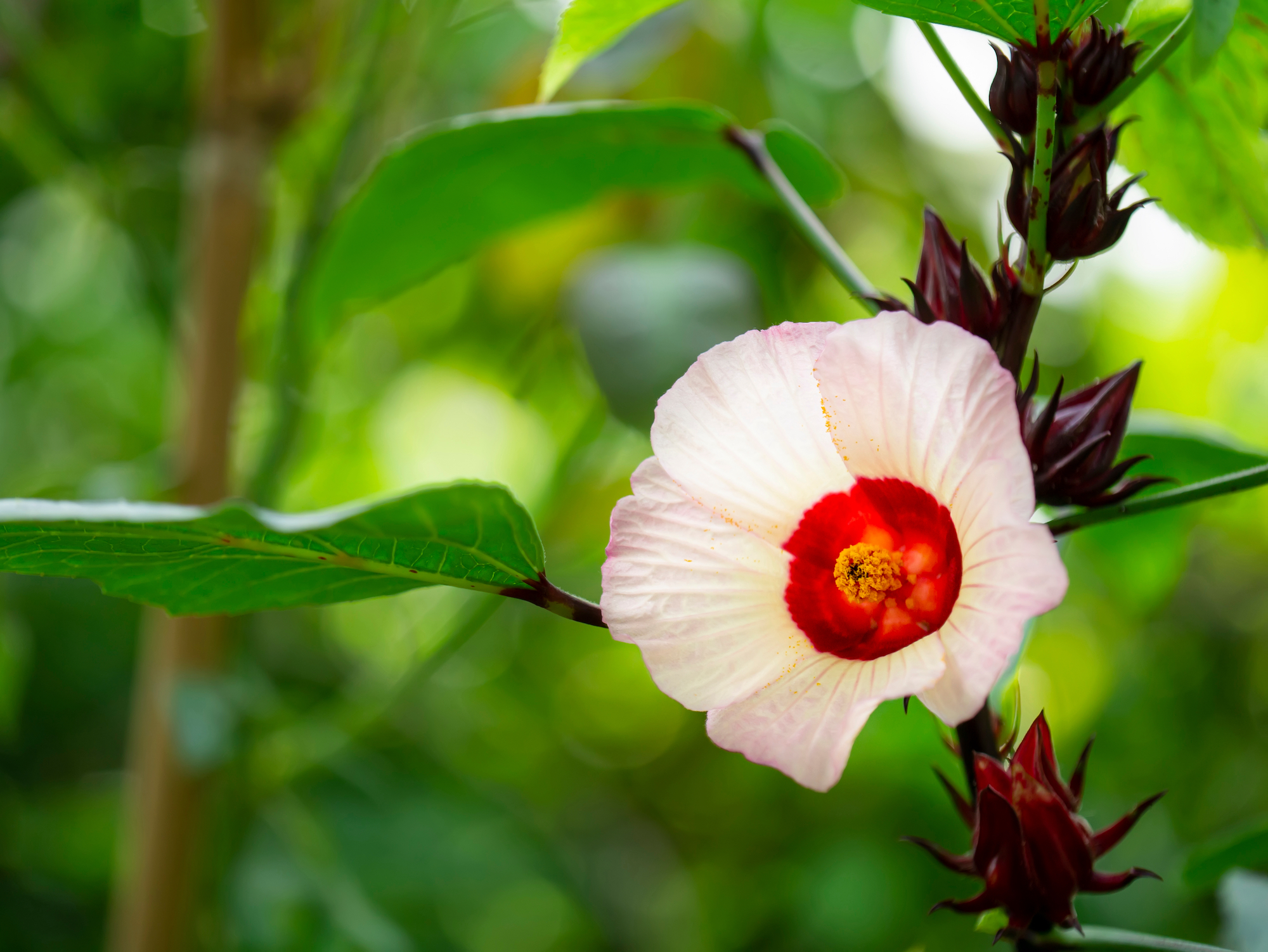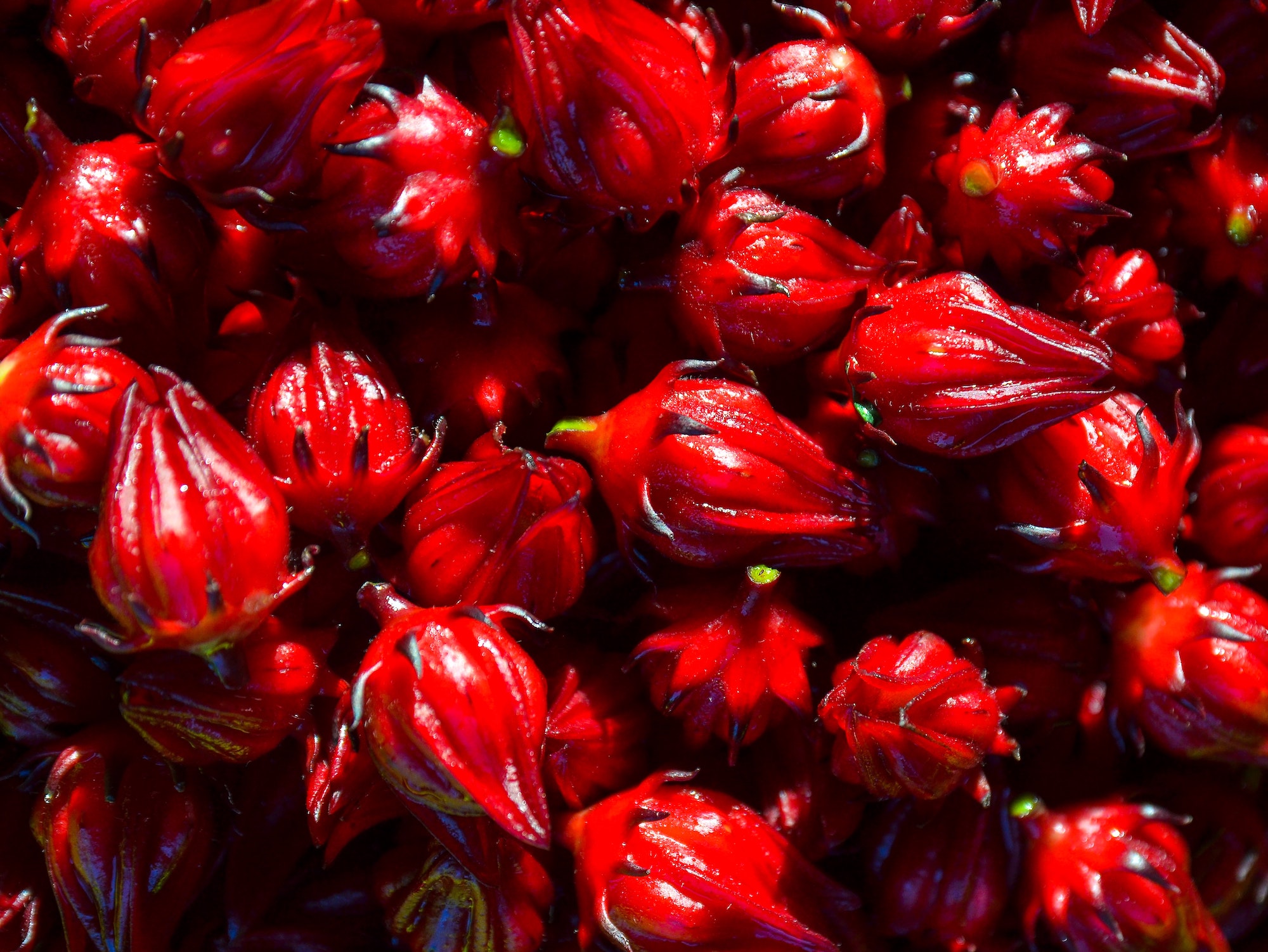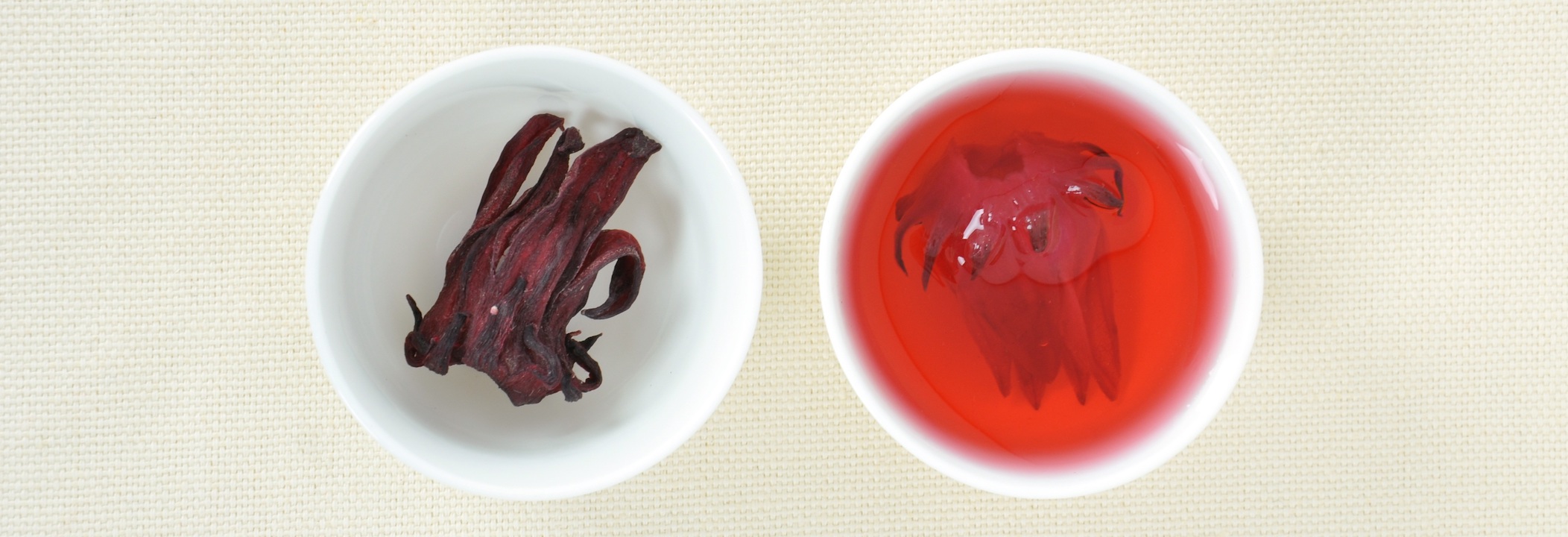Hibiscus sabdariffa
ENCYCLOPEDIA BOTANICA / HIBISCUS FLOWER
Hibiscus or rosella flowers are primarily used for their beautiful colour and flavour, which also have significant nutritional benefits. They are best suited and most often used in infusions or tinctures.
Description & Habitat
Rosella (Hibiscus sabdariffa) is also known as ‘hibiscus flower’ which can sometimes lead to confusion as there are over 260 species in the hibiscus genus, and there are two other species also well-known for their edible flowers—the iconic tropical hibiscus (H. syriacus) and Chinese hibiscus (H. rosa-sinensis). But it is H. sabdariffa that produces the ruby red calyxes that we commonly know and buy commercially as ‘hibiscus flower’ (yes, it’s the calyxes used, not the petals).
Hibiscus are part of the Malvaceae (mallow) family which also includes cotton, cacao, okra and hollyhocks. Rosella is likely native to India and East Asia, and the plant has been cultivated for centuries in Africa and is now naturalised in many temperate places around the world. It’s now widely-cultivated (usually as an annual) as it’s popular for its fruit, leaves, stems and mucilaginous roots.
The plant is a fast-growing bushy shrub that can reach over 2 metres high, and the flowers last for just one day. They bloom in the morning—white or pale yellow with a dark red centre, and turn pink and wither by the end of the day. It leaves behind a calyx, which will swell and ripen for 3-4 weeks until bright red, crisp and juicy. The plant’s stems are used for bast fibre which can be used as a substitute for jute.
Parts used: calyxes, seeds (also valued for its edible leaves, mucilaginous roots and fibrous stems)

Rosella (H. sabdariffa)

The calyxes of the rosella plant before drying
Aroma & Flavour Profile
Hibiscus flowers are used as much for their colour as for their flavour. They impart a glorious, deep red hue and vital acidity when steeped in both water or alcohol. The colour comes from anthocyanins and the sourness from vitamin C. The vitamin C affects the pH of infusions keeping the red colour relatively stable, as anthocyanins appear red in acidic conditions, but turn blue when the pH increases.
Rosella’s flavour is the jammy tartness of red fruits. It’s often likened to cranberry, rhubarb and raspberry, but has that citrus tang thanks to the vitamin C as well as tones of tart apple and grape. They are fruity and astringent like tamarind and rosehips, and burst in your mouth like sherbet. The fresh calyxes have a mucilaginous mouthfeel typical of all plants from the Malvaceae family, and the dried ones are even more intense, like very sour lollies.

Recommended techniques
• Simple infusions (teas) • Tincture • Infused oils • Spirits distillation (gin) • Maceration post distillation (gin/aromatic spirits/liqueurs) • Glycetract •
Uses
Teas and infusions
Hibiscus tea has been a popular infusion for centuries and is known by many names. It’s widely-known as karcadé in Egypt, and it’s from that Arabic name that we get the Italian drink called carcadé. Often, people will add some sugar, and different regions will add other flavours like ginger or mint, or fruit juices like lime, watermelon and pineapple (in Nigeria) or cinnamon bay and cloves (in Jamaica, where it can also be drunk with rum). In Southeast Asia the infusions are often more heavily sweetened and even sometimes turned into wine. Hibiscus flowers are rich in citric, malic and tartaric acid, which crop us in a range of fruits from citrus, through apple to grape, so these calyxes have been used as the flavour (and colour) of many commercial red fruit teas, especially those advertised as ‘berry flavour’. In the Lab hibiscus tea infusions are often used as syrups for zero-ABV cocktails, and in recipes for our herbal vermouths. You can find our favourite hibiscus tea recipe in The Archive.
Culinary
Rosella is used in many different culinary traditions in pies and pastries, sauces, ice creams, sorbets and syrups. It also makes excellent jams, jellies, chutney and pickles and the flowers are also used as tart seasonings in soups and stews. In the late 19th Century it was commercially cultivated in Australia to make roselle jam for export. The leaves are a good source of polyphenolic compounds, and many cooks in Africa, India and Southeast Asia incorporate the leaves into their cooking (they’re described as having an acid-rhubarb taste). In fact the entire plant can be consumed (in one way or another), though the root is quite fibrous and mucilaginous.
Skin care and cosmetics
Hibiscus flower is a popular addition to soaps and can be used in a range of body care products from hydrogels and body lotions. Rosella oil (which is an infused oil that utilises the seeds only, not the entire calyx) is gaining popularity in skin care products for its antioxidant properties.
Spirits
Rosella is a favourite of ours for herbal honey elixirs and bitters (where it’s first tinctured then blended). It can be used to enhance colour and flavour in liqueurs, or try adding a small amount to gins post-distillation if you are after a berry gin. You can simply steep the botanicals, or use a glycertract. Glycerine is more polar than ethanol but not as polar as water, so it is also a good medium for extracting a plant's more polar constituents. Of course, the glycertract turns a deep red colour. It can be used to sweeten teas or added to bitters, aperitifs, and digestives to sweeten and soften the mouthfeel while adding a sweet-tart quality and glorious colour. We have experimented making rosella quintessences in the Lab (distilled tinctures). Quintessences capture the volatile aromatic aspects of the plant, and we found rosella has a delicate aroma that quickly gets lost amongst more dominant aromatics in blends.
Tincture
In the Lab, we often tincture the dried flower for a concentrated extract. Tincturing keeps all the flavour qualities of the infusion (if not the exact colour) and can be stored much longer than the infusion. You only need to use 40% ABV for this tincture, as the colour compounds require a higher water percentage to extract fully. The tincture will be magenta red at first, but over time, it will oxidise to become more of a reddish-brown colour. We use this in bitters blends if making a digestif or an aperitif. It will create a freshness and a crisp, sharp mouthfeel similar to vinegar but without the accompanying vinegary smell and taste.
Natural dye
These beautiful red flowers have traditionally been used to dye wood and other materials in Africa, and there is a growing interest in it as a natural food colouring.



